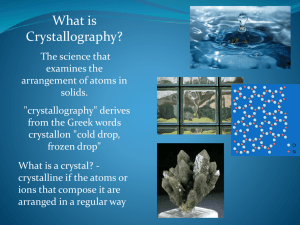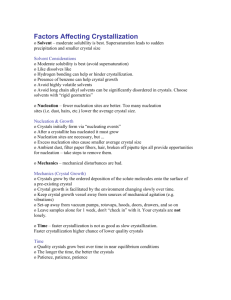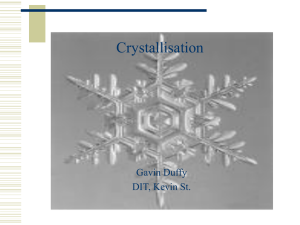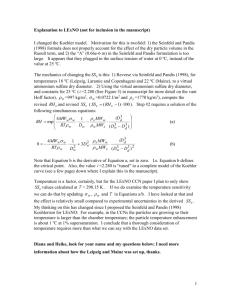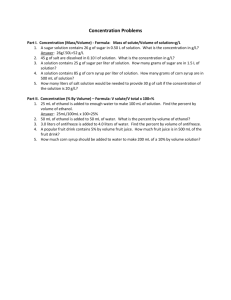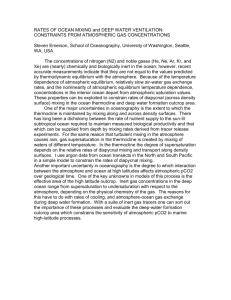Sugar Crystallisation Control : Sensor Performance
advertisement
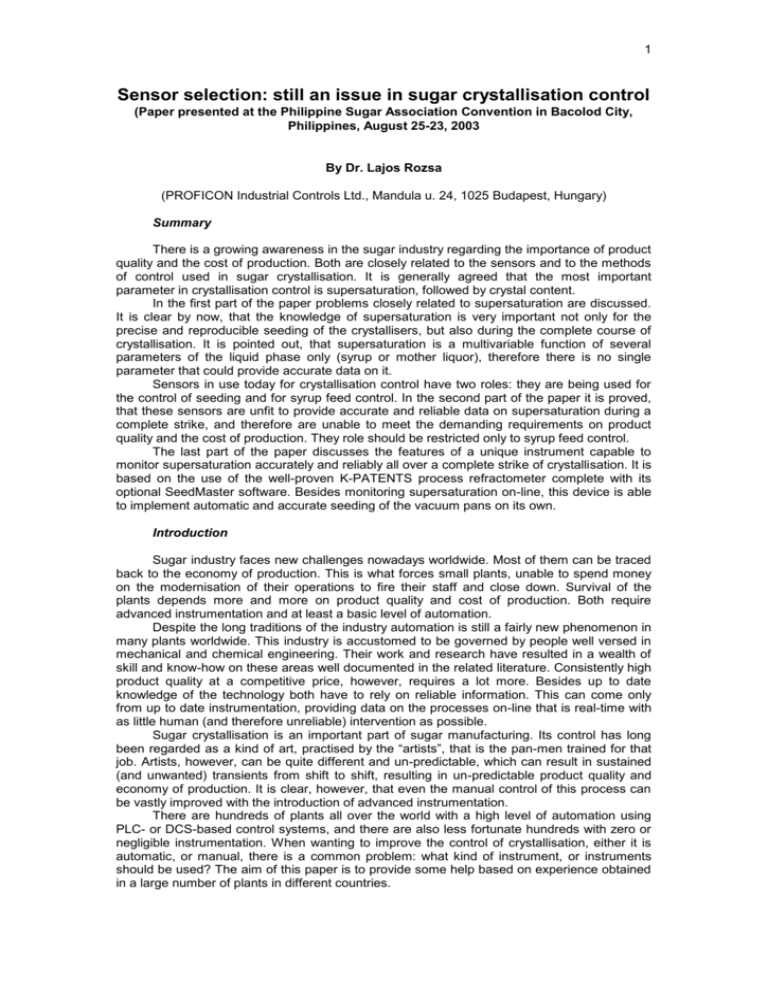
1 Sensor selection: still an issue in sugar crystallisation control (Paper presented at the Philippine Sugar Association Convention in Bacolod City, Philippines, August 25-23, 2003 By Dr. Lajos Rozsa (PROFICON Industrial Controls Ltd., Mandula u. 24, 1025 Budapest, Hungary) Summary There is a growing awareness in the sugar industry regarding the importance of product quality and the cost of production. Both are closely related to the sensors and to the methods of control used in sugar crystallisation. It is generally agreed that the most important parameter in crystallisation control is supersaturation, followed by crystal content. In the first part of the paper problems closely related to supersaturation are discussed. It is clear by now, that the knowledge of supersaturation is very important not only for the precise and reproducible seeding of the crystallisers, but also during the complete course of crystallisation. It is pointed out, that supersaturation is a multivariable function of several parameters of the liquid phase only (syrup or mother liquor), therefore there is no single parameter that could provide accurate data on it. Sensors in use today for crystallisation control have two roles: they are being used for the control of seeding and for syrup feed control. In the second part of the paper it is proved, that these sensors are unfit to provide accurate and reliable data on supersaturation during a complete strike, and therefore are unable to meet the demanding requirements on product quality and the cost of production. They role should be restricted only to syrup feed control. The last part of the paper discusses the features of a unique instrument capable to monitor supersaturation accurately and reliably all over a complete strike of crystallisation. It is based on the use of the well-proven K-PATENTS process refractometer complete with its optional SeedMaster software. Besides monitoring supersaturation on-line, this device is able to implement automatic and accurate seeding of the vacuum pans on its own. Introduction Sugar industry faces new challenges nowadays worldwide. Most of them can be traced back to the economy of production. This is what forces small plants, unable to spend money on the modernisation of their operations to fire their staff and close down. Survival of the plants depends more and more on product quality and cost of production. Both require advanced instrumentation and at least a basic level of automation. Despite the long traditions of the industry automation is still a fairly new phenomenon in many plants worldwide. This industry is accustomed to be governed by people well versed in mechanical and chemical engineering. Their work and research have resulted in a wealth of skill and know-how on these areas well documented in the related literature. Consistently high product quality at a competitive price, however, requires a lot more. Besides up to date knowledge of the technology both have to rely on reliable information. This can come only from up to date instrumentation, providing data on the processes on-line that is real-time with as little human (and therefore unreliable) intervention as possible. Sugar crystallisation is an important part of sugar manufacturing. Its control has long been regarded as a kind of art, practised by the “artists”, that is the pan-men trained for that job. Artists, however, can be quite different and un-predictable, which can result in sustained (and unwanted) transients from shift to shift, resulting in un-predictable product quality and economy of production. It is clear, however, that even the manual control of this process can be vastly improved with the introduction of advanced instrumentation. There are hundreds of plants all over the world with a high level of automation using PLC- or DCS-based control systems, and there are also less fortunate hundreds with zero or negligible instrumentation. When wanting to improve the control of crystallisation, either it is automatic, or manual, there is a common problem: what kind of instrument, or instruments should be used? The aim of this paper is to provide some help based on experience obtained in a large number of plants in different countries. 2 What are the data needed to control crystallisation? Most of the sugar produced worldwide is still being crystallised in batch-type evaporating crystallisers (vacuum pans). When automatic control is practised, the very basic parameters to be measured are: * level in the pan, * vacuum (absolute pressure), * massecuite temperature and * heating steam pressure, or flow. Besides this rudimentary information on the process there are two important parameters, which deserve more attention. These are supersaturation and crystal content. SUPERSATURATION Supersaturation and seeding of the pan. Crystallisation can only take place in solutions that are supersaturated, that is contain more solids in solution than necessary to saturation. Supersaturation of a saturated solution is exactly 1,0. A larger value indicates real supersaturation, while a lower one means that the solution is not saturated. Crystals can grow only if supersaturation is larger than 1,0. Supersaturation is the property of the solution that is in case of a solids-liquid mixture, like the massecuite, it depends solely on the parameters of the liquid phase (mother liquor). It follows then, that the required liquid parameters have to be measured selectively, that is any contribution from the varying crystal content should be disclosed. During batch crystallisation syrup fed in the pan is first concentrated by evaporation to reach real supersaturation. It is followed by seeding of the pan that is a very important operation. There are basically two different ways to implement seeding. Shock seeding is the old way of seeding, which is still being practised in many plants. It is characterised by a fairly high supersaturation in the seeding point, when by feeding a small amount of icing sugar (fine crystals), or specially prepared crystal slurry, the spontaneous formation of fine crystals is started (nucleation) in the supersaturated solution. The number of crystals generated depends very much on the actual value of supersaturation and on the time spent in the region of high supersaturation after seeding has been completed. When traditional manual control of crystallisation is practised, it is the pan-man’s responsibility to determine when seeding should be implemented and when to take measures (mostly by feeding more feed syrup and/or water) to decrease supersaturation in order to stop further nucleation. The pan-man determines the point of seeding by the string-proof that is by placing a small quantity of the concentrated syrup between the thumb and first finger and pulling them apart to form a thread, or by looking at the splash of the syrup on the pan windows. Both are related to the viscosity of the syrup, which is correlated to supersaturation. Having seeded the pan, some time later (still maintaining high supersaturation) the panman takes samples from the massecuite on a small glass plate to determine if there are already enough crystals for the batch. He relies on his eyes and previous experience to terminate nucleation of the massecuite. It can be seen that the result of shock seeding depends very much on supersaturation and on the length of the time of nucleation. If it is left to the pan-man without proper instrumentation, it is hopeless to expect good control of this important process. Full seeding is practised by using a carefully determined amount of crystal slurry and by seeding the pan at much lower supersaturation, which excludes spontaneous nucleation. As its name implies, in ideal case the number of crystals in the end product is exactly the same as it was in the slurry used for seeding. This can be achieved only by being always on the safe side that is maintaining supersaturation during the full course of the strike below that level, when spontaneous nucleation starts. 3 Supersaturation, product quality and cost of production. The ideal end product from strike to strike consists of well-formed single crystals of the same required size and number in a unit volume. Unfortunately, this aim can not be achieved. Crystal size distribution, the amount of fine crystals and conglomerates, and colour are important parameters when talking about product quality. It was proved by hundreds of researchers and in an equally large number of papers published world-wide that the main cause of the less than perfect product quality is very closely related to the value of supersaturation during the complete strike. As already discussed (see: Shock seeding), continuous nucleation can take place in the presence of crystals and high supersaturation. This will result in poor crystal size distribution and will make centrifuging of the product difficult. The traditional way to get rid of the fine crystals is to feed water into the pan. It was also proved in numerous papers that the formation of conglomerates (twin or multiple crystals) depends very much on supersaturation. This will again have serious consequences. Not only the crystal size distribution will be degraded, but product colour, too, because removal of the mother liquor during centrifuging from the multiple crystals is less than perfect. Some of the conglomerates usually are re-circulated after screening of the end product. Product quality and supersaturation problems can be traced back to * imperfect circulation of the massecuite in the pan, and * imperfect control of crystallisation. Poor circulation results in an inhomogenous supersaturation distribution. This can lead to high local supersaturation and (unwanted) nucleation. It is well known that pan circulation becomes inferior as the consistency of the massecuite keeps increasing with increasing crystal content. Imperfect control of crystallisation, either manual or automatic is most often due to the lack of appropriate instrument capable to measure supersaturation all over the strike. “Difficulties regarding the required sugar quality and crystal size distribution can be traced back repeatedly to the incorrect selection of supersaturation in the seeding point. Crystallisation is nowadays controlled by an automatic control system. This type of control is most often able to reproduce the trajectories of the set points quite well, but only with accuracy depending on the transmitter used. The inaccuracies and errors in the determination of the seeding point have considerable influence on supersaturation, when seeding is carried out. Unwanted high supersaturation and undersaturation can be equally observed” [1]. These observations come from a country, where automatic crystallisation control based on the use of the nuclear density probe is widespread. The cost of production depends on many parameters. It is well known that the speed of crystallisation and therefore boiling time of a given product is proportional to supersaturation. Plant managers usually are keen to have a high rate of production. This, naturally, can lead to such high levels of supersaturation, which will result in the problems discussed above. To fight them, water is usually being used. Considering now only some of those, that have a large contribution to the cost of crystallisation, we can say, that it is vital to prevent the problems that can be caused by dangerously high supersaturation. In this case: * There will be no need to use water. This would shorten boiling time and save energy. * Fine crystal and conglomerate content will be decreased. This will result in better crystal quality (size distribution and colour). * The amount of re-circulated (re-melt and re-crystallised) fine crystals and conglomerates will be reduced. This means that the yield of good quality crystals from a batch will be increased. Less re-circulated sugar and better yield translates into increased effective rate of production and lower cost. * Decreased supersaturation results in longer boiling times. This, however, would be amply compensated for by the time gained due to the positive effects listed above. Summing up: pushing production over a safe limit and this way providing a picture of good work can be misleading and costly. 4 On-line measurement of supersaturation Supersaturation is a multivariable function of the syrup or mother liquor parameters (for a detailed discussion see [2]), that is: Supersaturation = f (C, T, Q, m, b, c) (Eq.1.) where C : syrup or mother liquor concentration (%) T : temperature (C) Q : syrup or mother liquor purity (%) m, b, c : syrup quality parameters ( ) It can be shown that concentration C has the strongest effect on supersaturation. A 1 % change in syrup or mother liquor concentration has roughly 5 times larger effect on supersaturation as 1 % change in syrup purity, or 1 deg C change in temperature. These ratios, however, due to the strongly non-linear nature of the function are not constant. Syrup quality also has considerable effect on supersaturation. It is characterised by the “m”, “b” and “c” parameters of the Wicklund-Vavrinecz saturation function [3], which should be determined by the local laboratory. If these are not available, typical data can be used. Syrup quality parameters show changes only on a longer time scale (during the duration of a campaign), or due to changing the supplier of beet, or that of raw sugar in refineries. Concentration, temperature and mother liquor purity, however, have to be monitored on-line (real-time), if on-line monitoring of supersaturation is attempted. It should be clear by now that on-line measurement of supersaturation is a complex task. Concentration of the syrup or mother liquor should be measured by an appropriate sensor, which can do the job reliably and accurately during the complete strike, undisturbed by increasing crystal content and vapour bubbles. Purity of the liquid phase can change considerably, too. Starting from the purity of the feed syrup it drops well below this value by the end of the strike (for example: from 94 % to 88 % at 50 % crystal yield). Neglecting this drop in purity, done quite often when claiming on-line calculation of supersaturation, can result in serious errors. The same is true when syrup quality parameters are neglected. This is even more so, when low purity cane sugar syrups are being crystallised, which have a marked difference as compared to beet sugar ones regarding sugar solubility [4]. Summing up: there is no single sensor capable to provide data on supersaturation. Due to its multivariable nature, it can only be computed based on reliable data and taking into account all the parameters that determine it. CRYSTAL CONTENT Besides supersaturation, which is the most important parameter of crystallisation, crystal content has an important role, too. Having completed seeding, crystal size and mass begin to grow in a supersaturated solution. The growth of crystal mass is proportional to the crystal surface or to the second power of crystal size. To supply the sugar required to maintain this growth of mass, syrup should be fed into the pan accordingly. It is therefore important to have some kind of indication on crystal content. This information, however, is not that critical as those, which form the basis of the on-line monitoring of supersaturation. This means that no matter, what kind of sensors are being used to provide data on crystal content, the requirements regarding their accuracy are not that high. A closer examination of the current practice of crystallisation control reveals, that the sensors in use nowadays fill two roles: they are being used for seeding and for syrup feed control. It becomes clear (rather slowly), however, that they face an impossible task: their role should be restricted only to syrup feed control. 5 Sensor performance in monitoring supersaturation. Brief review of the sensors currently in use The sensors currently in use for crystallisation control measure one or two parameters of the syrup or massecuite, which can be * some electrical parameter; * viscosity or consistency; * attenuation of nuclear radiation; * attenuation and phase shift of microwave radiation; * boiling point rise, or * refractive index. Measuring electrical parameters. Probably the first attempt to have data somehow correlated to supersaturation was the introduction of conductivity probes operating at a few kHz frequency. Later on signal frequency was considerably increased (radio frequency or RF sensors), and besides conductivity, measurement of capacitance was implemented. In an excellent paper [5] it was shown that all electrical properties, measured at low- or radio frequency have a common form: LN(X) = a + b*Cml + c*Aml + d*CR + e*LN((T + 273)/100) (Eq. 2.) where X : measured conductivity, resistance or capacitance; Cml : syrup or mother liquor concentration (Bx); CR : crystal content (%); Aml : ash content of the syrup or mother liquor (%); T : temperature (C); a, b, c, d, e : constants, which are specific for the selected X parameter. The equation clearly shows the strongly non-linear and multivariable nature of the measured data. We should add an additional, missing parameter: composition of the nonsugars, which certainly influence the electrical properties, too. It can be seen, and the more detailed discussion in the paper proves that besides Cml any one of the electrical properties measured is strongly effected by changes in crystal and ash content (which are un-known), and temperature. This means that measurement of some electrical property is unfit to provide information on the concentration of the liquid phase selectively and, consequently, on supersaturation during the complete strike. It is also illusory to assume that any type of these data, even when there are no crystals yet present (before seeding the pan) will provide reliable information on supersaturation with the required accuracy. Measuring viscosity or consistency. Consistency probes have been manufactured by a few companies. The basic principle of operation is to measure the power consumption of a small electric motor driving a propeller intruding into the pan. Viscosity of solutions is closely correlated to their concentration. It is therefore natural to try to use viscosity data to give some information on supersaturation. Viscosity, however, depends on temperature and non-sugar content, too. We are facing again a situation, when some measured parameter, though correlated to liquid concentration and, therefore to supersaturation, is again a multivariable function. This means that precise and reproducible seeding can not be expected. The situation becomes even more difficult after seeding has been completed. Now we are talking about the consistency of the liquid-solids mixture what we call massecuite. As crystal content increases its contribution to the measured consistency increases sharply. Towards the end of the strike this contribution can exceed twenty times or more the one originating from the liquid phase (mother liquor), making viscosity of the mother liquor almost negligible. It follows then, that based on consistency data no information on mother liquor concentration, and therefore on supersaturation can be extracted. A simple and inexpensive way to get information on massecuite consistency is to use stirrer motor power consumption (instead of current consumption it is preferred to measure power consumption (kW)). In some cases it is being used to determine approximate crystal 6 content and control syrup feed. Due to its excellent sensitivity it is common practice to use it to signal the end of the strike. Measuring attenuation of nuclear radiation. Instruments that use nuclear sources became popular in the last few decades. Usually attenuation of nuclear radiation is translated into density or solids content of the massecuite. Density data, notwithstanding what kind of operating principle is being used, can provide reliable and accurate data on the concentration of the solution only until there are no crystals present, that is up to seeding of the pan. Having completed seeding, density depends on the concentration of the mother liquor and on crystal content. MASSECUITE DENSITY VERSUS MOTHER LIQUOR CONCENTRATION AND CRYSTAL CONTENTS (T_ml=74 C) 1520 1500 1480 DENSITY (kg/m3) CONCENTRATION=84 % 1460 1440 1420 CONCENTRATION=80 % 1400 1380 80 0 5 10 15 20 25 30 35 40 45 50 55 60 CRYSTAL CONTENTS, % Figure 1. Fig.1 clearly shows that it is impossible to get selective information neither on mother liquor concentration, nor on crystal content, if only a single measurement on the density of the massecuite is available. It can be seen for example, that innumerable combinations of concentrations ranging from Cml = 80 % to 84 % and crystal contents from CR = 7 % to 21 % will result in the same massecuite density Dma = 1420 kg/m3. The 4 % difference in mother liquor concentration, however, results in about 0,32 difference in supersaturation, which is very large indeed. This proves that any type of density measurement, if accurate enough, can be used only to determine the seeding point, but as the contribution from the crystals increases, density data will become increasingly useless for the monitoring supersaturation. Dissatisfaction with their use even for the determination of the seeding point was clearly shown in [1]. In the last few years we are witnessing a major problem with instruments using nuclear isotopes. The public became very sensitive to their use and began to fear and hate anything, what radiates, except the light bulbs. This feeling is even more pronounced, when radiation is being used in food processing. Another major cause for concern is the possibility of using radioactive material for terrorist purposes. There are already quite a few countries, where their use is already banned. No wonder, sugar plants all over the world are in a rush to replace their nuclear density probes with something else. 7 Measuring attenuation and phase shift of microwave radiation. Realising that nuclear probes have no future, some instrument manufacturers were promted to develop a new kind of instrument for their replacement. The new microwave probes are based on the measurement of the attenuation and phase shift of microwave radiaton. Both are closely related to * the length travelled by the radiated signal and to * the density and * dielectric characteristics of the medium. Phase shift is the result of decreasing speed of propagation. Due to the fact that water has a high dielectric constant compared to sugar and the accompanying non-sugars, water content (and, consequently, solids content) is the major parameter which determines the dielectric properties of the medium (this same argument was being used when the RF probes with capacitance output were introduced, too). Microwave probes provide, as output, density or solids content of the massecuite, the same way as the nuclear probes what they intend to replace. It is interesting to find, however, that one can rarely find data on the specified accuracy of measurement. They are a relatively new entry to the field with reported conflicting experience on their use. In a test run during the last campaign in one sugar mill in Hungary we have monitored syrup concentration data in a vacuum pan in the seeding points by a K-PATENTS PR-01-S refractometer and a microwave probe from Company X, located close to each other. It was logical to expect identical (in ideal case) concentration data in the seeding points. Monitoring several consecutive strikes it was found that concentration data measured by the microwave probe was always by 1,5 to 3,1 % larger than the one measured by the refractometer, showing random changes from strike to strike. In another test made recently in a refinery in Canada the microwave probe (from Company Z) reading during 4 strikes was -1,37 to -1,29 % lower in the seeding points than the data provided by the K-PATENTS refractometer. The difference in this case was almost constant, which means much better microwave probe stability in the seeding points. It is not known, however, how to achieve better calibration of the devices and how much the error in density or in massecuite solids content was after seeding had been completed. Summing up: any type of density or solids content measurement, if accurate enough, can be used only to determine the seeding point, but as the contribution from the crystals increases, density or solids content data will become increasingly useless for the monitoring of supersaturation. There are only two ways: as we have seen the largest effect on supersaturation comes from syrup or mother liquor concentration, which has to be reliably and accurately measured all over the strike, that is even when crystals are present in the massecuite. There are only two principles of measurement, which can live up to the task. Boiling point rise (BPR) of solutions. It is well known that the boiling point of sugar solutions in higher, than that of pure water at the same pressure. This boiling point rise is proportional to the concentration of the solution, therefore it could be used to provide data for the on-line supersaturation measurement. There have been and still are devices manufactured to monitor supersaturation based on this principle. BPR, however, depends not only on the concentration of the syrup, or mother liquor, but on its purity and on the composition of its non-sugars, too, which are difficult, or even impossible to compensate for. On the other hand, BPR of high-purity syrups is rather small, which makes its accurate measurement very difficult. No wonder, devices to monitor supersaturation based on BPR did not find wide acceptance. Refractive index of solutions. The refractive index of solutions depends on their concentration and temperature. The laboratory refractometer became the standard tool to measure the concentration of solutions since more than a century. The first attempts to design process refractometers to measure concentrations in-line, that is right in a pipe, or tank, and on-line, that is real-time started in the 1950-s. These refractometers measured the refractive index by using a single photo-element, providing an analogue signal (voltage) proportional to the illumination of the so called optical image. In 1983 K-PATENTS Oy, Finland pioneered the fully digital process refractometer, which is free from the errors and limitations characterising analogue signal processing. It is an extremely robust instrument with +/- 0,1 % accuracy, which is immune to the presence of crystals and vapour bubbles. Due to continuous development the K-PATENTS refractometer 8 became a reliable workhorse, among others, in the sugar industry, too. It has found widespread use worldwide in sugar crystallisation applications as well. The K-PATENTS PR – 01 – S type process refractometer. Evaluating sensor performance. Sensor preferences are varied and experience with their use is often contradictory. This is mostly due to the method of sensor evaluation generally practised, which is anything but quantitative. The objective evaluation of sensor performance should be based on real data on supersaturation [6]. During the 1996 campaign Kaba Sugar Co., Hungary (now a company of Eastern Sugar Co.) decided to use the method developed by PROFICON Ltd. for the on-line monitoring of supersaturation on one of their first product pans. It was intended to use it as a tool to supervise current practice in sugar boiling control and to gain experience with its use. The instrumentation of the pan included * a Radio Frequency (RF) probe made by a well-known manufacturer of RF probes with separate serial resistance and serial capacitance outputs; * a motor-driven consistency probe manufactured by Ziegler Co., USA ; * a PR-01-S type refractometer manufactured by K-PATENTS OY, Finland. Sugar boiling in the pan in case was controlled in the normal way by an ABB MOD300 type Distributed Control System (DCS) using one of the two outputs of the RF probe. The online calculation of supersaturation was also implemented in the DCS. Calculated data were trended for operator information on a monitor and stored, together with other relevant data for further processing (history data). The availability of reliable information on supersaturation provided an excellent opportunity to supervise the current practice of pan control and the performance of different sensors. Using data acquired every two minute during 3 strikes on October 27, 4 strikes on November 11, and another 6 strikes on January 3, the most important task was to analyse how do the different sensors perform in the seeding point during a longer period of time. In automatic sugar boiling control long-term stability and repeatability of supersaturation in the seeding points against the changes encountered in normal practice during a full campaign is of utmost importance. In this mill the Ziegler viscosity/consistency probe has been used (and is still in use with some other pans) to control sugar boiling. Later on a shift to the RF probe was enforced, but the experience gained with their use was not satisfactory. It was therefore natural that the output currently being used for the determination of the proper time for seeding, in this case the serial capacitance output of the RF probe had the highest attention. In Figures 2-5 supersaturation in the seeding points for the 13 strikes is shown as a function of RF serial resistance, serial capacitance, syrup viscosity and syrup concentration, measured by the RF and Ziegler probes and the refractometer, respectively. The lines and equations of the least square linear fits and the appropriate correlation coefficients are also shown. The figures and the data tell a lot about how well the different sensors are suited to control the seeding of a pan during a longer of time. 9 SUPERSATURATION IN THE SEEDING POINTS SUPERSATURATION 1.3 1.2 1.1 y = -0.017x + 2.2148 R2 = 0.1822 1 0.9 0.8 56 58 60 62 64 RF SERIAL RESISTANCE OUTPUT, % 66 68 Fig. 2. SUPERSATURATION IN THE SEEDING POINT SUPERSATURATION 1.3 1.2 Nov.11. 1.1 Jan. 3. 1 Oct.27-28 0.9 y = 0.0154x + 0.3476 R2 = 0.6015 0.8 40 45 50 55 RF SERIAL CAPACITANCE OUTPUT, % 60 Fig. 3. SUPERSATURATION IN THE SEEDING POINTS SUPERSATURATION 1.4 1.3 1.2 1.1 y = 0.0262x + 0.0497 R2 = 0.8266 1 0.9 0.8 35 37 39 41 43 45 ZIEGLER VISCOSITY OUTPUT, % 47 49 SUPERSATURATION Fig. 4. SUPERSATURATION IN THE SEEDING POINTS 1.4 1.3 1.2 1.1 y = 0.0694x - 4.3862 R2 = 0.952 1 0.9 0.8 77 78 79 80 81 SYRUP CONCENTRATION, BRIX (REFR.) 82 83 10 Fig. 5. As expected, syrup concentration measured by the K-PATENTS on-line refractometer gave the best results, as reflected by Fig. 5. and by the largest correlation coefficient. However, supersaturation is a function of other variables, too, which should also be taken into account as discussed in [2] (see Eq.1., too), that is the measurement of concentration alone is just not good enough to determine supersaturation with the required accuracy and repeatability. A note on this test is in order. The results discussed here certainly reflect a set of local parameters, or rather a change in these parameters during the campaign, like feed syrup purity and non-sugar composition, minor changes in massecuite temperature etc., which will not be exactly the same during the next campaign in this mill, and certainly are and will not be the same in other mills anywhere. They might be larger, or smaller, resulting in more or less changes regarding the different sensor outputs at the same level of supersaturation. This is the basic lesson to keep in mind when choosing a sensor for sugar crystallisation control. SeedMaster : a unique device to monitor supersaturation on-line and to implement reliable automatic seeding of vacuum pans. Recalling Eq.1. it is apparent, that though they provide data that are somehow correlated to it, none of the sensors discussed above is able to give data on the muchneeded supersaturation. If there is a change in the output of these instruments, it is not known how much of this comes, for example from the change of concentration, and how much is due to changes in the other variables (crystal content, or non-sugar composition, for example). One can find a large number of misleading and false claims in the related literature on measuring supersaturation, when measuring only conductivity, consistency, density or solids content of the massecuite, which, frankly speaking, nobody is interested in, when looking for supersaturation. Due to these difficulties sugar boiling control in use today as implemented by the pan-man, or by a control system most often is not based on the on-line monitoring and use of supersaturation. In its most advanced form, nuclear density probes, data tables and charts based on solubility data (sometimes outdated) are used to determine the density set-point for seeding in a rather trial and error procedure. Naturally, this procedure can not be used to implement on-line, closed loop control of supersaturation during a complete strike. The SeedMaster difference SeedMaster was developed in a joint effort by K-PATENTS Oy, manufacturer of the PR-01-S process refractometer and PROFICON Industrial Controls Ltd., the company having long experience in sugar manufacturing and crystallisation control. With the introduction of SeedMaster it finally became possible to have data on -line, real time on supersaturation, and reliable, reproducible automatic seeding of vacuum pans became reality. So, instead of relying on a bare minimum of instruments (manual control), or on the traditional ones and this way using false substitute data of questionable value, (manual or automatic control), supersaturation, the parameter that really counts, can be measured and used in a single dedicated instrument. SeedMaster relies on the use of a set of equations (mathematical model) developed to calculate supersaturation on-line, taking into account all the parameters (see Eq.1.) which completely specify it. It uses user-selectable data on sugar solubility collected by Grut or Vavrinecz (approved by ICUMSA). Syrup / mother liquor concentration and temperature are measured on-line by the well-proven K-PATENTS refractometer. Feed syrup purity, as determined by the local laboratory should be entered manually using the keyboard of the Indicating Transmitter (IT) of the refractometer. Syrup quality is characterised by the value of the Wicklund /Vavrinecz saturation function, which depends on the non-sugar to water ratio and some constants (the m, b and c parameters) to be determined by the local laboratory (if these data are not available, typical ones can be entered [4]). Based on these data supersaturation is re-calculated every second by the built-in microcomputer of the refractometer. These results are used to provide the basic features of SeedMaster. 11 Though the basic SeedMaster function is to provide help to the pan-man in seeding, or to implement automatic seeding on its own, it can be used to monitor supersaturation during a complete strike, too. SeedMaster functions. Calculated data on supersaturation are continuously displayed numerically and trended in diagram form versus time on the LC display of the Indicating Transmitter for local use, can be used to provide alarm signalisation, when supersaturation exceeds the high, or drops below the low alarm limit set by the operator, are available for transmission as 4-20 mA standard current output to other equipment (for example: to a chart recorder or to a boiling control system); can be used to implement precise and reliable automatic seeding of vacuum pans by switching ON a relay output ( opening the seeding valve) for a pre-selected time duration, when supersaturation reaches its selected set-point for seeding. SeedMaster can be adapted to continuous crystallisers, or cooling crystallisers of the sugar industry, or to the control of crystallisation of different products, for example, that of dextrose, too. SeedMaster was designed to provide the functionality listed above in optional software run by the microcomputer of the K-PATENTS PR-01-S process refractometer. All the original features of the refractometer are left unchanged and, naturally, do not need any authorisation. The SeedMaster software option, however, can be run only on K-PATENTS refractometer hardware, authorised (licensed) to do so. Refractometers already in use can be easily upgraded with the SeedMaster software option. Fig. 6. The Main SeedMaster Display. Conclusion. There has been a large amount of discussion in the industry on sugar crystallisation control during the last several decades. While everybody seems to agree on the importance of supersaturation as the governing parameter of crystallisation, it is surprising to find the confusion surrounding it. We can witness the improper use of terms related to it and can find a large amount of false claims on measuring supersaturation, when what is being measured is a massecuite parameter: conductivity, capacitance, density, solids content. Any one of these is a multivariable function of several un-known ones, and only have some correlation to supersaturation. With the increasing importance of product quality and cost this kind of oversimplification has to end. More and more mills realise world-wide, that it pays off to monitor real supersaturation on-line and use the data for advanced manual or automatic control of 12 crystallisation. The fully digital K-PATENTS process refractometer and its optional SeedMaster software result in a unique device, capable to provide the required supersaturation data and to implement automatic, reliable seeding of the vacuum pans. Using supersaturation trend data either on the LC display of the refractometer right on the spot, or on a remote monitor, pan-men, technologists and plant managers now are able to have a clear picture on what is really happening during a strike. The supersaturation trend line on a strike is like the electrocardiogram for the skilled doctor: problems can be easily identified and the required countermeasures can also be specified. But only if we know the real thing, what counts. References : [1] K.Bucholz, M.Bruhns: Über die Kampagne 1992 und Neuere Technische Entwiclungen. Zuckerindustrie, 118 (1993), Nr.5. 321-338. [2] Lajos Rozsa: On-line monitoring of supersaturation in sugar crystallisation. International Sugar Journal, 1996, 98, 660-675. [3] R.A. McGinnis: Beet-Sugar Technology. Beet Sugar Development Foundation, 3rd Edition, 1982, 378-381. [4] D.J.Radford, M.G.S. Cox: The Use of Electrical Properties Measured at Radio Frequencies for Pan Boiling and Brix Control. Zuckerindustrie, 111 (1986), Nr.10. 922-930. [5] Lajos Rozsa: Sugar solubility in impure cane sugar solutions. International Sugar Journal, 2000, 102, 230-235. . [6] Lajos Rozsa: Sensor performance in monitoring of supersaturation in sugar crystallisation. International Sugar Journal, 1997, 99, 263-268. [7] Lajos Rozsa: The SeedMaster device for on-line supersaturation measurement and automatic crystalliser seeding. International Sugar Journal, 1998, 100, 601-607. Note: Papers written by L.Rozsa can be downloaded from www.kpatents.com.
